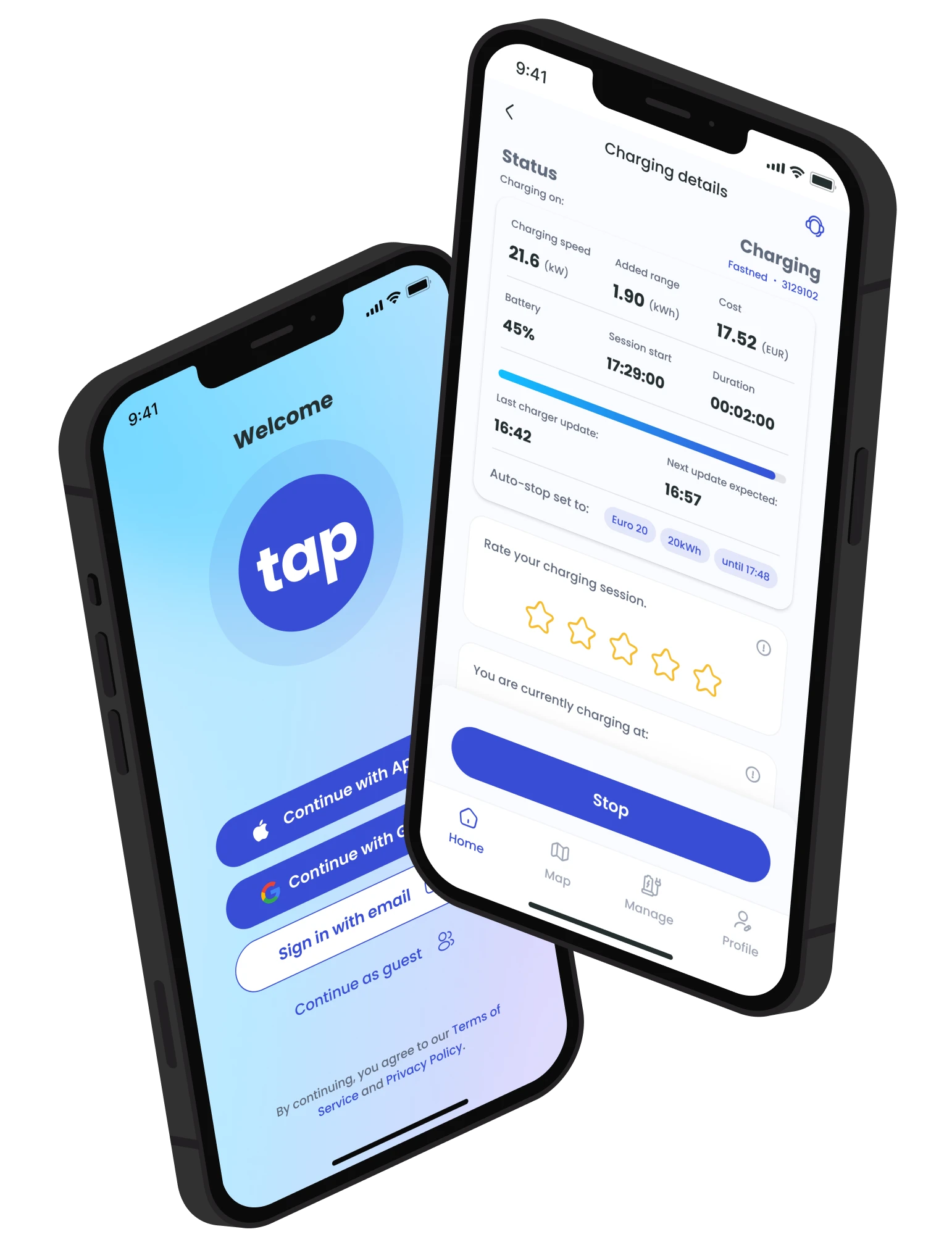So you’ve made a decision to get an EV – congratulations! Our experts have put together this comprehensive guide with helpful tips on EV charging in the Netherlands so you can make the most of your new car experience.
Data last updated 20 February 2024.
What does EV charging infrastructure look like in the Netherlands?
Charging stations
- There are over 140.000 public chargers where you can charge your car. That gives the Netherlands the densest network of public chargers in the world!
- Different companies operate chargers. They’re responsible for maintaining and managing their network of chargers. Some of the largest networks in the Netherlands include Fastned, Equans and TotalEnergies.
- Municipalities can give the right to more than one company to operate charging networks within the same neighbourhood. That’s why you may see Equans or Vattenfall operated chargers within walking distance of each other.
- The term “roaming” refers to agreements between charge point operators who supply chargers, and mobility service providers. These agreements enable you to use one app or RFID token to access many charger networks. For example, with your Tapkey you can access every major network in the Netherlands, such as E-Flux, Equans, Eneco, Vattenfall, TotalEnergies, Shell Recharge, Allego, Fastned, and Ionity.
Types of chargers
- Chargers are classified based on how fast they can deliver power to your vehicle. There are 2 main types of chargers: AC power and DC power. AC chargers tend to be less than 22kW, while DC chargers tend to be over 50kW. Thus, DC chargers are often called fast chargers.
- You can find a wide range of AC and DC chargers across the public network that differ on price and power.
- The majority of public chargers in the Netherlands are either rated at 11kW or 22 kW.
- There are over 4.000 fast chargers in the Netherlands. Fastned and Ionity are popular fast charger networks, with high powered chargers that can often deliver up to 150kW. Some chargers are even rated up to 375kW, but most vehicles cannot yet handle this kind of power.
Charging apps or charge cards
- Service providers like Tap Electric enable you to use public chargers. They provide the software that communicates with operators so that you can start and stop your charge session and pay for your energy.
- You can use an app or EV charge card from a provider to charge your car.
- A charging app can help you find available chargers, check pricing, pay for charging, and more. Available features vary widely between apps.
- Nationaal Laadonderzoek (2023) shows that Dutch drivers typically have 2-3 charge cards.
- With a charge card or charge key, you can simply tap it against a charger’s card reader to start a charge and tap it once more to stop the session. With our Tapkey, your charge session will immediately show up in the Tap app and you can track progress there.
- While charge cards can be very convenient, they are not the most secure method of payment, as cards can be easily stolen or copied. The Tapkey is the only charge card on the market with 2 factor authentication available via the Tap app.
- 0% transaction fee / session – only pay the operator cost
- Free Tapkey charge card for easier charging starts
- Pay session costs monthly
- Coverage across the Netherlands, Belgium, Germany, France, Luxembourg, Austria and UK
How to charge your electric car
- Using an app:
- Find an available charger
- Plug in your cable, make sure the cable is firmly connected to the car and the charger
- Press the start charge button that corresponds to the charger outlet you’re using
- Pay for your charge session
- Using an RFID charge card:
- Find an available charger
- Plug in your cable
- Hold your RFID charge card against the reader on the charger to start or stop your session
Cost of charging
- The cost of your charging session will depend on your provider. The price you’ll pay will depend on provider’s rate structure
- The operating costs plus transaction costs
- A fixed rate per kWh
- Bundles of kWhs
- Your total session cost may include transaction fees and subscription costs aside from VAT.
- Most chargers use a simple tariff where you pay a price per kWh, however more operators and owners are starting to use complex tariffs. You can read more about this in our analysis on the average price per kWh Dutch drivers pay to charge their car and why price spread matters.
- A complex tariff can consist of multiple tariffs for your one session. For example, on top of the price per kWh you consume, you may also need to pay an hourly price for every you’re connected to the charger and/or a starting cost where you get charged with a flat fee to plug in.
- You may save more on your charging by taking out a subscription from a provider. For example, if you charge often you can save by subscribing to a plan like Tap Roamer where you pay no transaction fees every time you charge. See how you could save with our comparison of popular charge cards in the Netherlands.
- Prices are not always transparent and can change daily or even throughout the day. This is where a charging app like Tap is helpful to see the latest charger prices, including a visualisation for changes throughout the day. This includes kWh prices, starting, idle and parking costs.
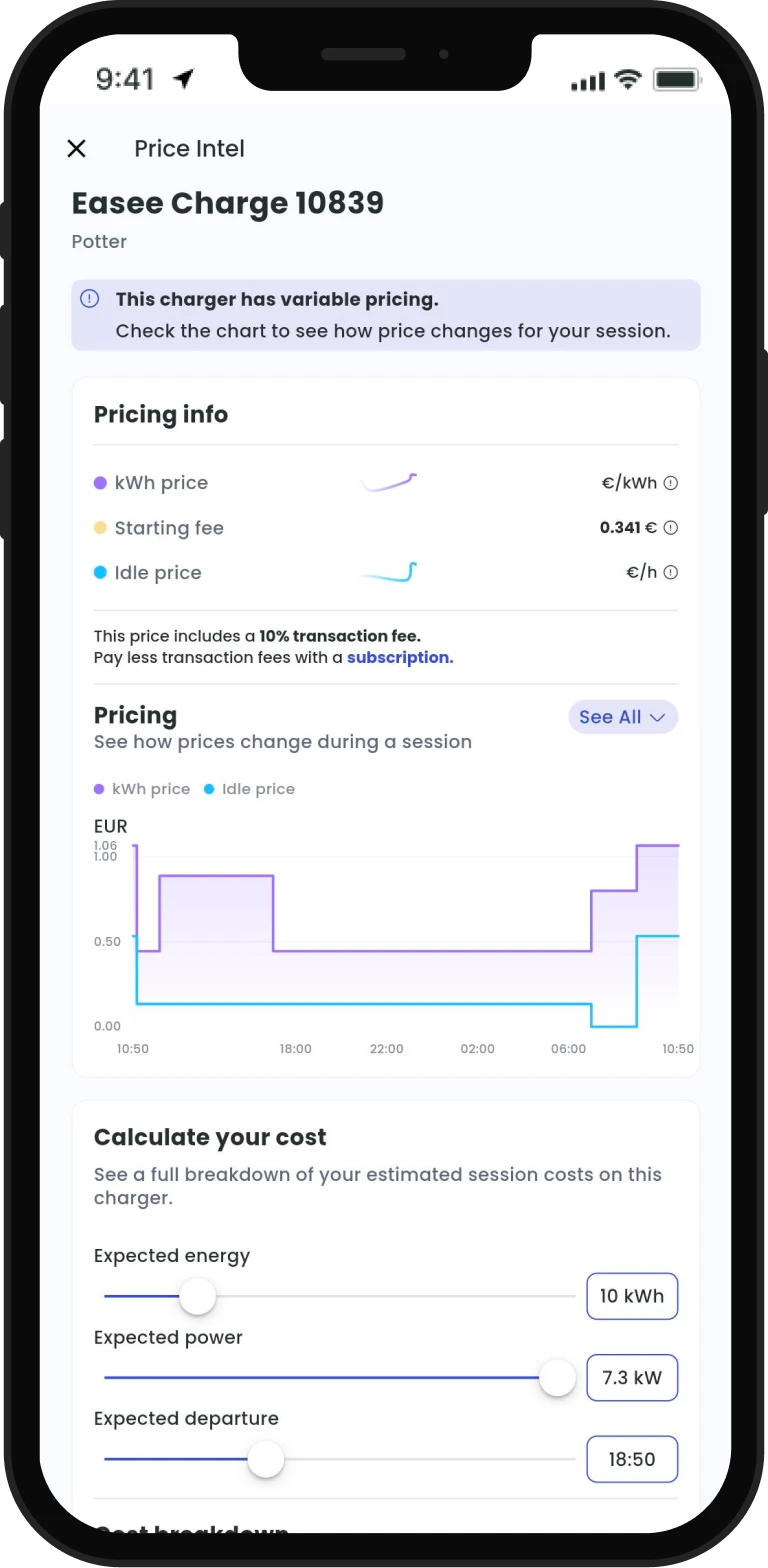
Tips for EV drivers
1. Get a charging app with clear pricing details
All providers must show you charging prices before your charge session and your final price must reflect the rates that were shown to you beforehand. However, charger pricing details are not consistent between apps.
In the Tap app, the prices you see are inclusive of operator cost, VAT and transaction costs (if any).
Plus ‘Price Intel’ shows you a full breakdown of charger tariffs, your expected session price and you can compare prices between popular charge cards in the Netherlands so you can check if you’re getting a fair price.
Pro tip: Compare charger prices often
Our analysis shows there’s an significant average price difference between equivalent normal chargers within walking distance of each other. Yep, you’re getting the same power, but could be paying more than you need to.
2. Take note of complex pricing
Some chargers have complex pricing where an operator or owner has set dynamic pricing and/or multiple fees to use their charger.
Complex pricing include:
- Peak and off-peak prices: you pay different price per kWh based on the time of day you use the charger.
- Operators or owners may use this to pass on the fluctuating cost of energy throughout the day.
- Starting fee: you pay a price per session to plug in your car.
- Parking or idle fee: a price per hour kicks when your car stops charging but still connected to the charger.
In the Tap app, you can check if any charger has a complex pricing in Price Intel. You can also check if there’s an equivalent cheaper charger nearby.
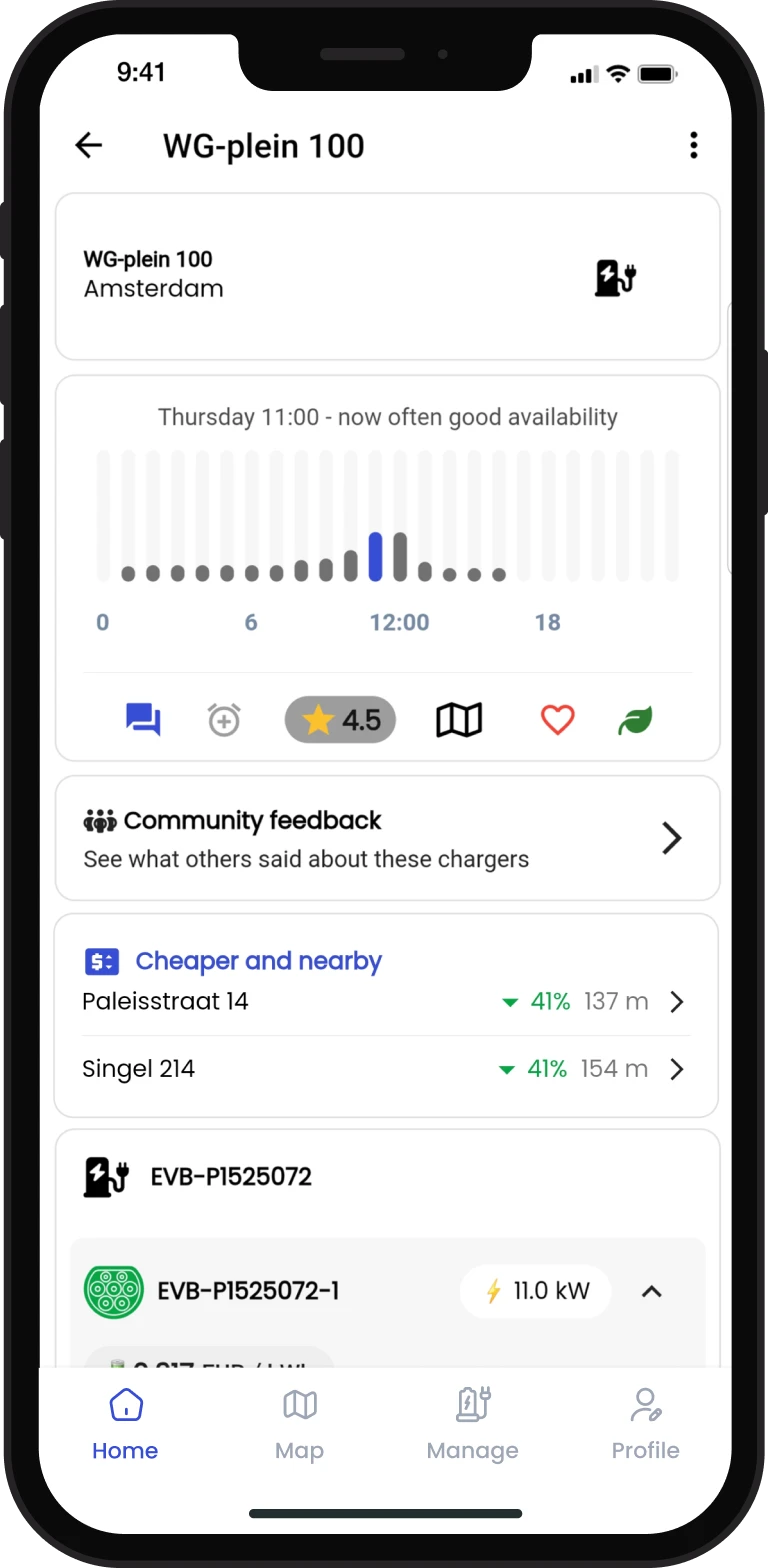
3. Look for a solid or flashing light on the charger when you start a session
Not sure if the charger is working? If you see a white, blue or green light turn on or flash on the charger, then your app or charge card has done its job. When nothing happens, or if you see a red or orange light, the session was not authorised. Operators can help you if the charger is not working properly – there is generally a phone number listed on the charge station.
Pro tip: Use a charge card or charge key for easier charging starts
One downside of using an app to start a session is that if there is poor internet signal, it may not work. A charge card or key in most cases still start your charge session even if there’s no internet connection.
4. Charge cheaper with AC chargers
Most Dutch drivers use AC chargers for day to day use. AC chargers are cheaper than fast chargers. This is because AC power charging infrastructure is simpler and cheaper to implement than DC.
Since AC chargers have lower power levels, charging your car takes longer than on fast chargers.
You can better plan your charging sessions by knowing how much energy you’re planning to consume. You can check the average consumption of watt hours of your car battery pack per kilometre on Electric Vehicle Database measured as Wh/km.
For example, on a Tesla Model 3, you consume 139 Wh/km. If you charge for 1 hour at an 11kW AC charger, you would be getting approximately 11 kWh of energy. This would equate to around 79km of range.
5. Save more by comparing charge card prices on every charger
The total cost of your session changes depending on the charge card you use to pay for your session. This is because your price structure changes depending on the provider charge card.
While it’s possible to order a charge card from providers without a subscription like Tap Electric, Road (formerly known as E-Flux), ANWB and Vattenfall, you typically get the most value when you have a charge card with a subscription.
With a charge card with a monthly subscription, you may benefit from:
- Less or no transaction fees
- Cheaper rate structures if you charge on certain networks
- Rewards or discounts
Things to consider when choosing a subscription include monthly subscription cost, charger pricing at your go-to chargers, fees, your driving habits and app features that improve your charging experience.
Tap has the cheapest subscriptions in the Netherlands and all our plans come with a Tapkey, even on our free plan.
Pro tip: Use Price Intel in the Tap app to compare charge card prices
You can see which EV charge card has the best price on many chargers in the Netherlands like Equans, Fastned and TotalEnergies – more coming soon. Pricing with the Tap Roamer subscription is usually the cheapest option, and we’re upfront when it’s not – that’s how transparency works!
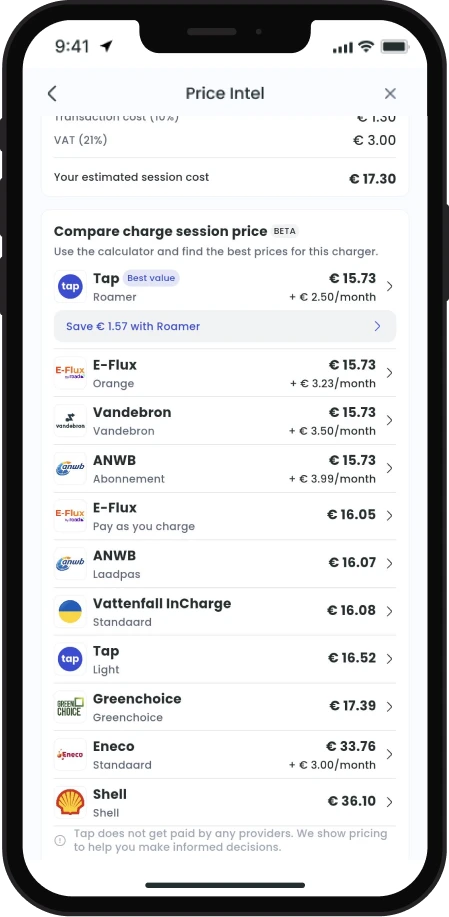
6. Charge with dynamic tariffs when you can
Dynamic tariffs enable electricity prices to vary based on the time of day and demand on the grid. If you’re charging during off-peak hours, you could save on your energy bills compared to fixed-rate tariffs.
If you have your own charger and have a dynamic tariff from your energy provider, connect your charger to Tap and save big. By enabling our dynamic tariff control program, we will charge your car during the cheapest moments of the day, guided by the local electricity market prices.
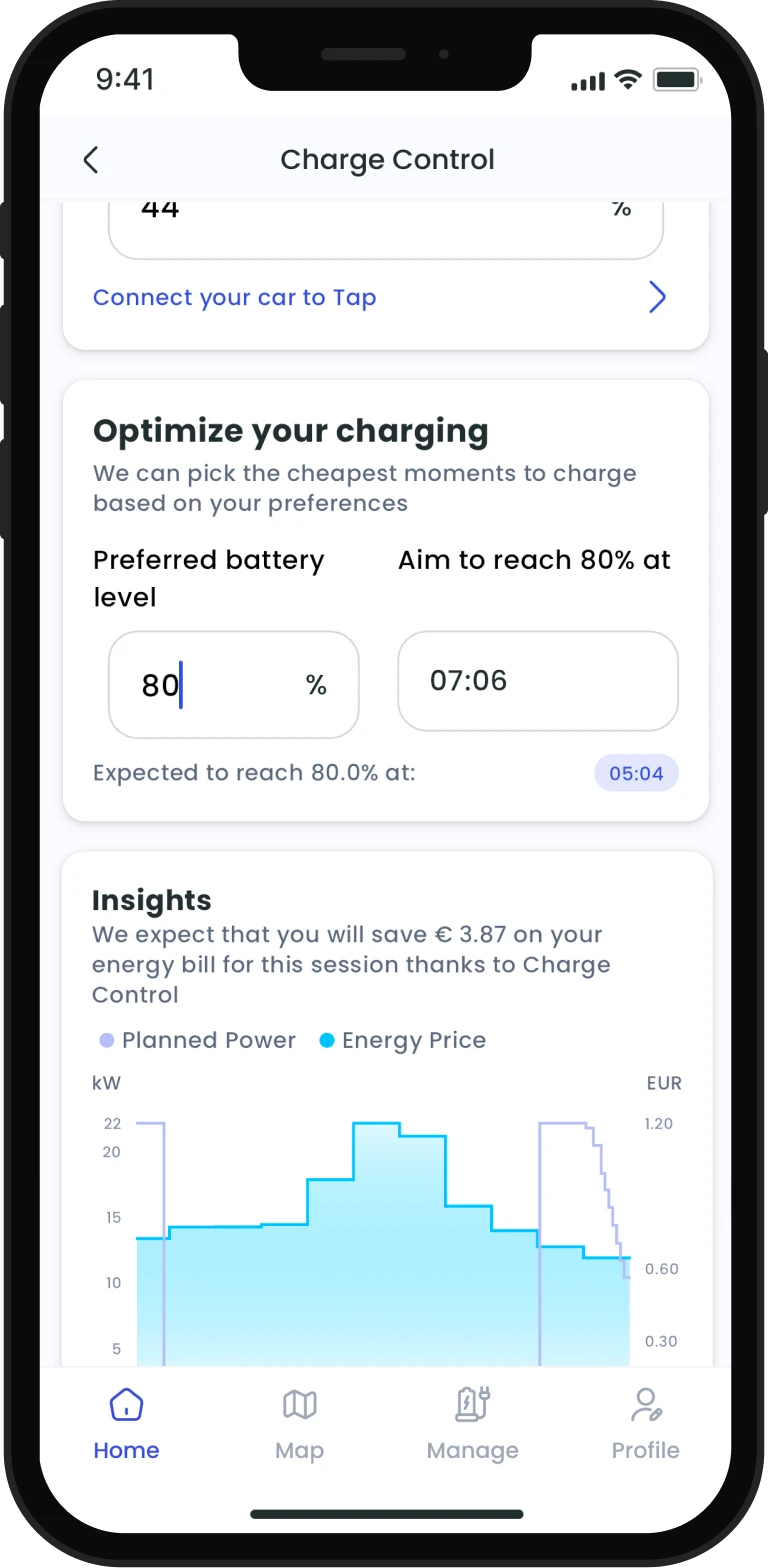
7. Plan for slower charging rates as your battery gets full
Nearly all modern EVs use a tapered charging curve which slows down charging speeds when your battery is nearly empty, and then again as the battery gets closer to being fully charged. Understanding the charging curve of your car will help you plan how much time you need to be at the charger. In general, your car can charge most quickly when the battery level is in the range of 20 – 80%.
8. Keep battery health in mind
It’s recommended to keep the battery at 30-80% charged with minimal numbers of chargers and not charge the battery to 100% for better battery health. Research by Recurrent suggests maintaining the charge level of the battery within a range around 50% where the battery is most chemically stable. Their experiments have indicated that battery cells may last longer if you take small amounts of energy out of your battery at a time also known as a small depth of discharge.
Most modern EVs have an advanced battery management system that manages and optimises your charging to prevent overcharging or undercharging your battery cells. You can charge to 100% every now and then to help recalibrate the battery management system in your car and maintain accurate state of charge readings.
Pro tip: Connect your car to Tap for live battery level updates during your charge session.
With Tap app, you can connect your car and get real-time battery level insights during charge sessions on car brands like Tesla, Kia and Hyundai. This can help you keep track of your battery health over time.
9. Be a considerate at public charging stations
If you’ve finished charging, free up your spot so that other drivers can use the charger. More operators and owners are using parking/ idle and blocking fees to stop drivers from overstaying. By doing your part, we may see less of these tariffs!
10. Max out your range with regenerative breaking
Regenerative braking or regeneration is a feature in EVs where it converts kinetic energy back into electrical energy during braking or deceleration. In other words, you’re charging your car battery every time you brake.
The amount of energy you convert from regeneration depends on many factors like elevation, speed and driving style. However, driving at a steady pace is always more efficient than braking.
11. Connect your charger to Tap and earn money
If you own a charger, you can connect your charger to EV drivers with Tap for free and potentially earn money every time someone uses your charger. You can set your own tariffs, location access and unlock savings from your dynamic energy contract using Tap’s charge control program.

